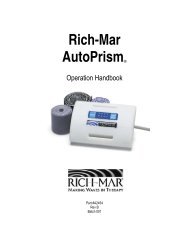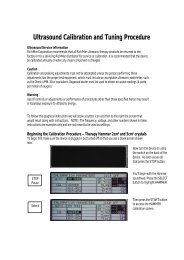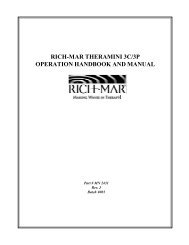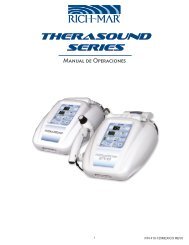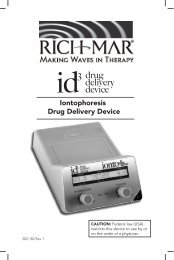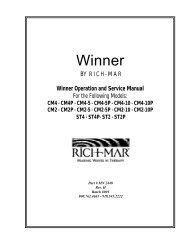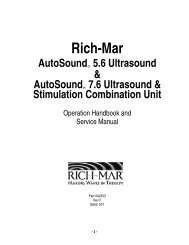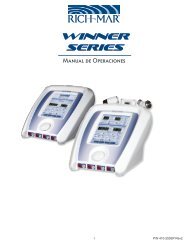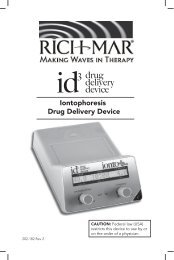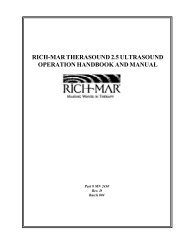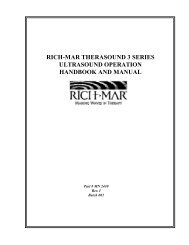Phototherapy Treatment Manual - Rich-Mar Corporation
Phototherapy Treatment Manual - Rich-Mar Corporation
Phototherapy Treatment Manual - Rich-Mar Corporation
Create successful ePaper yourself
Turn your PDF publications into a flip-book with our unique Google optimized e-Paper software.
<strong>Treatment</strong>GuidelinesHeadacheGuidelines Explanation 4TREATMENT SCHEDULEMIGRAINETENSIONCERVIOCOGENICX perWEEK# ofWEEKSdaily PRN2-3 4-62-3 4-6TREATBILATERAL TREATMENTBelow mastoid process, semispinalis, upper trapeziusand sternocleidomastoid muscles.VER. 1.3 © RICH-MAR 200910-16 Continuous10-16 Pulsed @ low0100 - 01600101 - 0161JOULESdosePULSINGjoules modeCONSOLE SETTINGTREAT8-148-14ContinuousPulsed @ low0080 - 01400081 - 0141Select 4-6 sites based upon pathology. Trigger points; semispinalis,upper trapezius, sternocleidomastoid muscles and points of tenderness.For retro-orbital headaches treat Liv 3 and LI 4 acupuncture points.
<strong>Treatment</strong>Guidelines5 Guideline ExplanationTREATABLE CONDITIONSRelated clinical conditions are clustered and treated with a similar protocol.The selection of treatment sites vary based upon the assessment, diagnosis and outcomes.TREATMENT SCHEDULEGenerally, for the first week: Treat up to 5 x per week then to the lower range by week 2.Acute conditions can be treated 1-2 x daily as warranted.Chronic conditions: Longer duration and less frequent treatments (2-3x weekly).LASER , SLD, LASER + SLD ICONSUse treatment sites for both Laser and SLD, providing a comprehensive approach.Based on the pathology select the most appropriate treatment sites.Also refer to <strong>Treatment</strong> Notes at bottom of the protocol page.BILATERAL TREATMENTFor purposes of clarity, treatment sites for Laser and SLD have been illustrated onone side of the body only. Treat bilaterally as required.TREATAdditional information to assist with using the specific treatment guideline.VER. 1.3 © RICH-MAR 2009JOULESA joule is a unit of energy. One joule is the equivalent of one watt of powerradiated or dissipated for one second. (e.g. 200mw Laser Cluster deliversone joule per 5 seconds. 500mW SLD Cluster delivers one joule/cm 2 per 45 seconds).Time is automatically set with dose selection.PULSINGPhoton energy can be delivered in a continuous stream or pulsed (bursts of energyper second). Guidelines provide both continuous (black) and pulsed settings (grey)for treatment. See following pages for further treatment details.RICH-MAR pulsed settings:1 - Low = 8 pulses / second,2 - Medium = 146 pulses / second and3 - High = 1000 pulses / second.Pulsed mode and continuous mode can be alternated between sessions.DEVICE SETTINGSConsult your RICH-MAR Operation Guide for full operational details for the specific RICH-MARdevices.For the RICH-MAR Console setup, the numerical sequence listed is a rapid method of programmingthe treatment console settings and must be used under the "<strong>Manual</strong>" 'O' category.Example:0 10 0<strong>Manual</strong> Setting Joules Continuous or Pulsed (1-3)Note: For the Portable Laser – once dose is selected, it delivers the dosethen automatically shuts off. Each audible beep indicates one joule has been deliveredand three rapid beeps indicate the treatment cycle is complete.
<strong>Treatment</strong>Guidelines<strong>Treatment</strong> PrinciplesThe delivery of light energy and the dose requiredto treat target tissue is influenced by a number of factors.Consult the RICH-MAR <strong>Treatment</strong> <strong>Manual</strong> as a starting pointfor a range of suggested doses.6Starting with the smallest dose in the protocol addadditional joules of energy based upon the following parameters:Age - small children & frailty (e.g. dehydrated older patients),use smallest dose in the protocol.Size of treatment area - larger areas require combinedSLD & Laser treatment for beneficial local and regional effects.Pigmentation - melanin in darker skin absorbs more energyat the surface, requiring a larger dose for deeper target tissue.Depth of target tissue - deeper target tissue requires more energyto deliver therapeutic dose (gentle pressure = greater penetration).Type of tissue - Adipose tissue (less vascular) requires less energythan muscle mass (more vascular) for energy penetrationto target tissue.Continuous vs. Pulsed Wave ModeUse continuous mode for acute conditions.Generally use 1 - Low setting for chronic conditions.Change from continuous to pulsing (or vice versa) when:a) there is no treatment response after a few treatments orb) positive progression hits a plateau.Based on the literature, the following pulsed settingshave been programmed into the RICH-MAR Console System:VER. 1.3 © RICH-MAR 2009Option 1 = 8 Hz Pain, NeuralgiaOption 2 = 146 Hz General Stimulation, Trigger pointsOption 3 = 1000 Hz Edema, Inflammation
<strong>Treatment</strong>Guidelines7 Comprehensive <strong>Treatment</strong>A comprehensive treatment approach results in more rapid,successful outcomes (Generally a minimum of 2 approaches should be used).Assessment, diagnosis and testing results will determinewhich of the following areas require treatment:Entire injured or affected areaNerve root or superficial nerve trunksMotor or trigger pointsReferred areas of painAcupuncture and / or auricular pointsFor extensive edema, treat proximal (centrally) to distal (towards extremities),to open up the lymphatic pathway to enhance drainage.VER. 1.3 © RICH-MAR 2009<strong>Treatment</strong> StepsDegrease skin by cleansing with soap and water or alcohol.Broken skin, cover cluster or area with clear plastic wrap for barrier.Position patient for most direct access to target tissue.Use protective goggles when using the laser,not required with SLD treatment.Position laser or SLD in direct, firm skin contact,directing energy towards target tissue.Do not move device during treatment,keep in one position until completed.<strong>Treatment</strong> ScheduleAcute Conditions - Treat daily to 3 times weekly until significantsymptom relief is achieved, especially for patients with trauma,herniated discs and acute back pain. <strong>Treatment</strong> may last1-3 weeks with 6-15 treatments.With competitive athletes, treatment may be delivered 2-3 times per daywith a minimum of 2-4 hours between sessions, for rapid response.Once sufficient improvement or pain relief is achieved, treat 2-3 timesper week and decrease dosage for healing until achieving significantimprovement or full resolution.
<strong>Treatment</strong>Guidelines<strong>Treatment</strong> Schedule (cont’d)Chronic Conditions - Treat 2-3 times weekly,up to 15-25 treatments. Maintenance treatment may be requiredfor chronic degenerative conditions.Consistent schedule of treatments augmentthe accumulative effects enhancing outcomes.8Occasionally, pain can increase following the first few treatments,(2 - 4 hours post treatment until the next day).This is referred to as a 'treatment reaction', an indication thatthe light energy may have "pushed" the chronic conditioninto a sub-acute phase of healing. Forewarn patientsso ice or analgesics can be used. Once this pain subsides,pain levels are generally less than pre-treatment ratings.Next session, decrease treatment dose by 50%and gradually increase over time.Frail individuals, small children and patients with degenerativerheumatoid arthritis, fibromyalgia or other autoimmune conditions,should be treated initially with smaller doses.Gradually work up to full dosage.Patients may initially state they feel "fatigued" by treatment.Constant re-testing and clinical outcomesdictate when patients are discharged.Use of Other ModalitiesOther modalities may be unnecessary with phototherapy.If combining modalities, treatment sequence is important:VER. 1.3 © RICH-MAR 2009If icing, use before phototherapy(vasoconstriction decreases blood flow, improving light penetration).If massage or heat generating therapy (e.g. ultrasound, e-stim)is used, apply after phototherapy(vasodilation increases blood flow, diminishing penetration of light).
<strong>Treatment</strong>Guidelines9 ContraindicationsDo not treat:Directly into the eyes (retinal exposureto Class 3B laser, may cause eye damage)(Does not apply to SLD)Over a pregnant uterusOver any suspicious lesion or active cancerOver thyroid glandOver an area injected with steroidsor other anti-inflammatory medicationwithin the past 72 hoursReferencesBaxter D., Therapeutic Lasers: Theory & Practice, 1994Kert J. & Rose L., Clinical Laser Therapy, 1989VER. 1.3 © RICH-MAR 2009Oshiro T. & Calderhead R., Low Level Laser Therapy, 1988Pöntinen P., Low Level Laser Therapy as a Medical<strong>Treatment</strong> Modality, 1992Tunér J. & Hode L., The Laser Therapy Handbook , 2004Siminovic Z., Lasers in Medicine and Dentistry, 2000Websiteswww.laser.nuwww.naalt.orgwww.walt.orgwww.nasa.govwww.darpa.milwww.richmarweb.comRICH-MARwww.richmarweb.com4120 South Creek Road, Chattanooga, TN 37406info@richmarweb.com 888.549.4945 service@richmarweb.comThese <strong>Treatment</strong> Guidelines have been prepared for internationaluse. Each clinician must ensure that the particular treatmentsemployed comply with any restrictions as specified by local,professional and regulatory agencies.
Copyright © 2009 RICH-MAR Inc.All rights reserved. This book is protected by copyright.No part of this book may be reproduced in any form or by any means,including photocopying, or utilized by any information storage andretrieval system without written permission from the copyright owner.The publisher is not responsible (as a matter of product liability, negligenceor otherwise) for any injury resulting from any material contained herein.This publication contains information relating to general principles ofmedical care which should not be construed as specific instructionsfor individual patients. Manufacturers' product information and package insertsshould be reviewed for current information, including contraindications,dosages and precautions.First Edition 2009P/N 000-155CreditsAnita SaltmarcheRN, BScN, MHScHealthCare AssociatesTorontoDr. Nimet MeghjiOptimum Health CentreTorontoDavid Saltmarche DesignTorontoGuideline Researchand DevelopmentClinical ConsultantDesign, Illustration, Digitals
Head & NeckCervical SpineFacial PainHeadacheTemporomandibular Joint DysfunctionSinusitisHerpesSimplexShoulder & ArmShoulderElbowHandCarpal Tunnel SyndromeSpine & HipThoracic SpineLumbosacralHipHerpes ZosterLeg & FootKneeAnkle & FootPlantar FasciitisOtherFibromyalgiaWoundsCharts of Acupuncture Points
Head&NeckSLD Laser SLD and Laser
CervicalSpineTREATMENT SCHEDULETORTICOLLISWHIPLASH INJURIESFACET JOINT SYNDROMECERVICAL RADICULOPATHYHERNIATED DISCOSTEOARTHRITISREFLEX SYMPATHETIC DYSTROPHYX perWEEK# ofWEEKSdaily PRN3 4-82-3 2-42-3 4-62-3 4-62-3 4-82-3 4-6VER. 1.3 © RICH-MAR 2009TREATBILATERAL TREATMENTAreas of pathology: including para-cervical muscles from C1-T2.Select appropriate SLD cluster positions. Treat bilaterally or unilaterallybased on symptoms.12 - 1812 - 18JOULESdoseContinuousPulsed @ mePULSING0120 - 01800122 - 0182joules modeCONSOLE SETTINGCONSOLE code SETTINGTREAT10 - 1810 - 18ContinuousPulsed @ me0100 - 01800102 - 0182Areas of pathology and pain: including para-cervical nerve roots from C1-C7.Trigger points or tender points: mastoid process, semispinalis, upper trapeziusand along the posterior margin of the SCM muscles. Additional acupuncturepoints: LI 4 and Si 3.
FacialPainTREATMENT SCHEDULEBELL'S PALSYATYPICAL FACIAL PAINTRIGEMINAL NEURALGIA (V1, V2, V3)POST HERPETIC NEURALGIAX perWEEK# ofWEEKS3 3-62-3 3-63 3-63-5 2-4V1,2V3V2V1V1V3V2V3VER. 1.3 © RICH-MAR 2009TREATOver TMJ and masseter muscle. Treat bilaterally.6 - 206 - 20JOULESdose6 - 166 - 16ContinuousPulsed @ lowPULSINGContinuousPulsed @ low0060 - 02000061 - 0201joules modeCONSOLE SETTING0100 - 01600061 - 0161TREAT Trigger/acupuncture points. Select 4-6 points based on symptoms.
HeadacheTREATMENT SCHEDULEMIGRAINETENSIONCERVIOCOGENICX perWEEK# ofWEEKSdaily PRN2-3 4-62-3 4-6VER. 1.3 © RICH-MAR 2009TREATBILATERAL TREATMENTBelow mastoid process, semispinalis, upper trapeziusand sternocleidomastoid muscles.10 - 1610 - 16ContinuousPulsed @ low0100 - 01600101 - 0161JOULESdose8 -148 -14PULSINGContinuousPulsed @ lowjoules modeCONSOLE SETTING0080 - 01400081 - 0141TREATSelect 4-6 sites based upon pathology. Trigger points: semispinalis,upper trapezius, sternocleidomastoid muscles and points of tenderness.For retro-orbital headaches treat Liv 3 acupuncture point.
TREATMENT SCHEDULETemporomandibularJoint Dysfunction(TMJ)X PERWEEK#WEEKS2-3 4-6VER. 1.3 © RICH-MAR 2009TREATTMJ, masseter and temporalis muscles, bilaterally.Select cluster sites appropriate to pathology.10 - 2010 - 20ContinuousPulsed @ me0100 - 02000102 - 0202JOULESdose6 - 126 - 12PULSINGContinuousPulsed @ mejoules modeCONSOLE SETTING0060 - 01200062 - 0122TREATTMJ (mouth closed) and posterior aspect of joint (mouth open).Trigger points: masseter and temporalis muscles. Treat bilaterally.
SinusitisTREATMENT SCHEDULEALLERGIC SINUSITISMAXILLARY SINUSITISX perWEEK# ofWEEKS1-2x dailyas required.VER. 1.3 © RICH-MAR 2009JOULESdose6 - 86 - 8PULSINGContinuousPulsed @ lowjoules modeCONSOLE SETTING0060 - 00800061 - 0081TREATOver the maxillary and frontal sinuses bilaterally, as indicated.
HerpesSimplexTREATMENT SCHEDULEX perWEEK# ofWEEKS1-2x daily until resolved.VER. 1.3 © RICH-MAR 2009TREATLesion using direct contact.Cover SLD cluster with clear plastic wrap.6 Continuous 0060JOULESdosePULSINGjoules modeCONSOLE SETTING6Continuous0060TREATTreat tender lymph nodes.
Shoulder&ArmSLD Laser SLD and Laser
ShoulderTREATMENT SCHEDULEARTHRITISDELTOID TENDONITISSUBDELTOID BURSITISBICIPITAL TENDONITISIMPINGEMENT SYNDROMEROTATOR CUFF SYNDROMESUPRASPINATIS TENDONITISADHESIVE CAPSULITIS (FROZEN SHOULDER)X PERWEEK#WEEKS2-3 4-82-3 3-62-3 3-62-3 3-62-3 3-62-3 3-62-3 3-62-3 3-6VER. 1.3 © RICH-MAR 2009TREATSurround area of pathology, potentially including trapezius muscle, insertionsites and trigger points for supraspinatus, infraspinatus, teres major, anteriorand posterior joint capsule.10 - 2010 - 20JOULESdose10 - 2010 - 20ContinuousPulsed @ mePULSINGContinuousPulsed @ me0100 - 02000102 - 0202joules modeCONSOLE SETTING0100 - 02000102 - 0202TREAT Over area of pathology. Acupuncture points Li 14, 15, 16, TW 14 and Si 11.
ElbowTREATMENT SCHEDULEMEDIAL EPICONDYLITISLATERAL EPICONDYLITISOLECRANON BURSITISX perWEEK# ofWEEKS3 3-63 3-63 2-4MEDIALLATERALVER. 1.3 © RICH-MAR 2009TREATOver area of pathology, medial or lateral epicondyle or bursa.If pain radiates, treat along the involved muscle.10 - 1610 - 16ContinuousPulsed @ high0100 - 01600103 - 0163JOULESdose8 - 168 - 16PULSINGContinuousPulsed @ highjoules modeCONSOLE SETTING0080 - 01600083 - 0163TREATMedial epicondyle and flexors. Lateral epicondyle and extensors.If pain is present on palpation, repeat treatment up to 3 times.Lateral may require larger treatment doses.
HandTREATMENT SCHEDULEFRACTURESOSTEOARTHRITISRHEUMATOID ARTHRITISDE QUERVAIN'S TENOSYNOVITISX perWEEK# ofWEEKS3-5 2-42-3 4-82-3 4-62-3 4-6VER. 1.3 © RICH-MAR 2009TREATDorsal and palmar aspects of affected areas.10 - 1410 - 14JOULESdose8 - 148 - 14ContinuousPulsed @ mePULSINGContinuousPulsed @ me0100 - 01400102 - 0142joules modeCONSOLE SETTING0080 - 01400082 - 0142TREATDorsal and palmar side of site(s) including trigger point on thenar muscle.* Additional acupuncture points: SP 6 (immune point for RA).
CarpalTunnelSyndromeTREATMENT SCHEDULEX perWEEK# ofWEEKSPERIPHERAL NERVECOMPRESSION 3 4-8BILATERAL TREATMENTVER. 1.3 © RICH-MAR 2009TREATOver transverse carpal ligament and thenar muscle. Follow the course ofthe median nerve based upon symptoms. Also treat C5-T1.10 - 1410 - 14ContinuousPulsed @ me0100 - 01400102 - 0142JOULESdose8 - 148 - 14PULSINGContinuousPulsed @ mejoules modeCONSOLE SETTING0080 - 01400082 - 0142TREATOver area proximal to flexor retinaculum to mid palm following the course ofthe median nerve.If pain radiates up arm, follow along median nerve. Also treat para-cervicalregion and tender points along SCM muscle. Additional acupuncture point Li 4.
Spine&HipSLD Laser SLD and Laser
ThoracicSpineTREATMENT SCHEDULEMYOFASCIITISCOSTOCHONDRITISCOMPRESSION FRACTUREX perWEEK# ofWEEKS2-3 4-62-3 2-43-5 2-4VER. 1.3 © RICH-MAR 2009TREATBILATERAL TREATMENTSelect one or more SLD cluster positions as indicated by pathology.Repeat until affected area is covered.12 - 2012 - 20ContinuousPulsed @ me0120 - 02000122 - 0202.TREATJOULESdose10 - 2010 - 20PULSINGContinuousPulsed @ mejoules modeCONSOLE SETTING0100 - 02000102 - 0202Trigger points, below mastoid process, semispinalis, trapezius andrhomboid muscles.
LumbosacralTREATMENT SCHEDULEDISC HERNIATIONSCIATIC NEURALGIALUMBAR FACET SYNDROMELUMBOSACRAL STRAIN/SPRAINSACROILIAC JOINT DYSFUNCTIONOSTEOARTHRITIS + - FORAMINAL STENOSISX perWEEK# ofWEEKS3-5 4-82-5 4-82-3 2-42-3 2-42-3 2-42-3 4-8VER. 1.3 © RICH-MAR 2009TREATBILATERAL TREATMENTTreat bilaterally or unilaterally based upon pathology. Select appropriate SLDcluster sites. Apply over SI joint if involved.If required, increase pulsing to high.14 - 2014 - 20ContinuousPulsed @ high0140 - 02000143 - 0203JOULESdose6 - 206 - 20PULSINGContinuousPulsed @ highjoules modeCONSOLE SETTING0060 - 02000063 - 0203TREATOver SI joint and a total of 4-6 points based upon pathology.Acupuncture points: GB 34, GB 30, ST 36, BL 57, BL 60 and SP 6.
HipTREATMENT SCHEDULEOSTEOARTHRITISCAPSULITISTROCHANTERIC BURSITISX perWEEK# ofWEEKS2-3 4-82-3 3-62-3 3-6VER. 1.3 © RICH-MAR 2009TREATBILATERAL TREATMENTAnterior and posterior hip. Repeat over lateral hip.At least one pulsed setting should be used.10 - 2010 - 20ContinuousPulsed @ high0100 - 02000103 - 0203.TREATJOULESdose10 - 2010 - 20PULSINGContinuousPulsed @ highjoules modeCONSOLE SETTING0100 - 02000103 - 0203Anterior, posterior and lateral hip can be treated with both SLDand Laser simultaneously.
HerpesZoster(Shingles)TREATMENT SCHEDULEInitially.Follow-up.X perWEEK# ofWEEKS2-43 4-8VER. 1.3 © RICH-MAR 2009TREATCover cluster with clear plastic wrap prior to treatment. Treat involvednerve root(s) and dermatomes. Initially hold cluster .5-1 inch abovelesions until sufficient pain control achieved. When possible, usedirect skin contact.10 - 1410 - 14JOULESdose8 - 128 - 12ContinuousPulsed @ mePULSINGContinuousPulsed @ me0100 - 01400102 - 0142joules modeCONSOLE SETTING0080 - 01200082 - 0122TREATCover Laser with clear plastic wrap prior to treatment. Treat theinvolved nerve root(s) and dermatomes. Initially treat .5 - 1 inch abovelesions until sufficient pain control achieved. When possible, use directskin contact. Acupuncture points: Li 4, ST 36, K 3 and P 6.
Leg&FootSLD Laser SLD and Laser
KneeTREATMENT SCHEDULEOSTEOARTHRITISCHONDROMALACIA PATELLALIGAMENTOUS INJURIESOSGOODE SCHLATTER’S DISEASEMENISCUS INJURIESPOST-OP REHABX perWEEK# ofWEEKS2-3 4-82-3 4-62-3 3-62-3 3-62-3 3-63-5 4-6.. . .. .VER. 1.3 © RICH-MAR 2009TREATTreat with knee flexed to open up joint space. Treat over joint line andinclude upper quadrant and popliteal space if indicated by pathology.10 - 1810 - 18JOULESdose8 - 188 - 18ContinuousPulsed @ highPULSINGContinuousPulsed @ high0100 - 01800103 - 0183joules modeCONSOLE SETTING0080 - 01800083 - 0183TREATMedial and lateral joint lines and other sites of pathology.
AchillesTendonitisTREATMENT SCHEDULEX perWEEK# ofWEEKS3 4-6VER. 1.3 © RICH-MAR 2009TREATOver tendon insertion at calcaneus.Medial and lateral aspects of Achilles tendon.12 - 1812 - 18JOULESdose8 - 188 - 18ContinuousPulsed @ mePULSINGContinuousPulsed @ me0120 - 01800122 - 0182joules modeCONSOLE SETTING0080 - 01800082 - 0182TREATTendon insertion at calcaneous and origin of soleus andgastrocnemius muscles.
Ankle&FootTREATMENT SCHEDULESOFT TISSUE INJURIESANKLE SPRAINOSTEOARTHRITISBUNIONFRACTUREREFLEX SYMPATHETIC DYSTROPHYX perWEEK# ofWEEKS2-3 3-43-5 3-62-3 4-82 2-43-5 2-42-3 4-6..VER. 1.3 © RICH-MAR 2009TREATOver affected area(s). With extensive swelling, first treat lymphaticdrainage in groin, posterior knee and finally, injury site.10 - 1810 - 18ContinuousPulsed @ me0100 - 01800102 - 0182JOULESdose6 - 186 - 18PULSINGContinuousPulsed @ mejoules modeCONSOLE SETTING0060 - 01800062 - 0182TREAT2 - 4 most painful points over affected area(s).
PlantarFasciitisTREATMENT SCHEDULEX perWEEK# ofWEEKS2-3 3-6VER. 1.3 © RICH-MAR 2009TREATOver insertion of fascia at metatarsals and origin of plantar fascia at calcaneus.12 - 1812 - 18JOULESdose10 - 1810 - 18ContinuousPulsed @ mePULSINGContinuousPulsed @ me0120 - 01800122 - 0182joules modeCONSOLE SETTING0100 - 01800102 - 0182TREAT3 - 5 most painful areas, including over insertion of fascia at metatarsalsand origin of plantar fascia at calcaneus.
OtherSLD Laser SLD and Laser
TREATMENT SCHEDULEFibromyalgia 3X perWEEK# ofWEEKS4-6VER. 1.3 © RICH-MAR 2009TREATBILATERAL TREATMENT8 - 128 - 12JOULESdose6 - 106 - 10ContinuousPulsed @ lowPULSINGContinuousPulsed @ low0080 - 01200081 - 0121joules modeCONSOLE SETTING0060 - 01000061 - 0101TREATOption 1: Treat tender points: suboccipital area, lower cervical spine (transverse processof C5-C7), upper trapezius, supraspinatus, 2nd rib (costochonial junction), lateralepicondyle (2 cm distal), gluteal, greater trochanter of femur, medial fat pad at the knee.Option 2: Treat as indicated on diagram.Monitor patient's level of fatigue and decrease time per site if needed.Do not exceed a total of 60 joules laser energy.
1Wound HealingIntroductionResearch indicates that phototherapy can accelerate woundand tissue repair by as much as 30% - 40%. Best results areacheived when phototherapy is an adjuct to an evidencebasedWound Care Program. <strong>Phototherapy</strong> can be usedin conjunction with all types of dressings and types of woundregardless of stage.The Mechanism of Action diagram (Introduction pg. 3) outlinesthe physiological activities that are stimulated by phototherapy.The cumulative effect of the multiple inter-active processes andevents is an accelerated inflammatory cycle with diminishedsymptoms and earlier normalization.VER. 1.3 © RICH-MAR 2009Since phototherapy does not exacerbate the inflammatory processbut rather condenses the time frame from onset to resolution throughacceleration of processes, it can be used immediately post injury.Rapid initiation of therapy in acute inflammation assists in limitingthe scope and duration of the inflammatory event and minimizesthe pain and severity associated with it.Most of the beneficial phototherapy effects seen in acute inflammatoryevents are also initiated in more chronic inflammatory conditions,such as chronic wounds.The light energy accelerates and enhances healing activities carriedout by the body. Several of the unique characteristics of phototherapythat work to alleviate pain and inflammation also play an important rolein accelerating the healing process.<strong>Phototherapy</strong> positively impacts the wound healing progress throughthe stages of inflammation, proliferation, remodeling and maturation,in open surface wounds as well as closed connective or soft tissueinjuries.
Wound Healing<strong>Treatment</strong> Protocols2Remove and discard dressing.Cleanse wound bed and surrounding tissue.Debride dead tissue as required.For open areas cover wound or phototherapy device(which ever is larger) with clear protective barrier .Protective goggles are to be worn by patientif laser device is used (not required for SLD devices).Apply SLD / Laser with gentle contact for duration of treatment.(If painful, hold device as close as possible without contact.Once pain relief is achieved, use direct skin contact).Stage 1 & 2 Wounds (closed or partial thickness)Unless too painful, use SLD devices to treat theentire wound margin and wound bed directly (increasing blood flow,decreasing localized edema, reducing redness and swelling in the area).Stage 3 & 4 Wounds (full thickness)If less than 3 cm depth,treat entire wound margin and wound bed with SLD.If greater than 3 cm depth,use Laser device around wound margin.Note – If wound aperture is significantly smaller than underlyingwound bed, do not treat opening directly. Treat the peripheraltissue directly over the internal wound edge with either theSLD or Laser, depending upon the depth required.<strong>Phototherapy</strong> enhances contraction of the wound margins.Over the wound bed, use either the SLD or Laser device,depending upon the size of the wound opening.VER. 1.3 © RICH-MAR 2009Monitor amount and quality of granulation tissue formation.If over production (hypergranualtion) is noted,decrease the number of phototherapy treatments per week.If hypergranulation continues, cease the intervention.
3Wound HealingStage X – Dark Eschar over WoundIf the dark eschar is going to be debrided, treat with either SLDor Laser device for the prescribed treatment time. Eventually,the wound will become soft (boggy) making debridment easier.Healing will begin from the inside out.Note – Only use phototherapy if goal of treatmentis intervention rather than 'wait and see'.For frail and elderly individuals, the presence of a closed,non-draining, black eschar can be preferable to a woundthat is open and draining. Stage X wounds can be deep,requiring a protracted healing time.Number of <strong>Treatment</strong>sVER. 1.3 © RICH-MAR 2009The most significant effects are often evident in the first 3 weeksof phototherapy followed by gradual healing. After completing25 treatments, phototherapy is often stopped for a 'light holiday'to determine whether the wound will continue to heal on its own.If healing stops or regresses, reinitiate phototherapy for anotherset of 25 treatments or until healed.Exudate ProductionFor the first couple of weeks, the amount of exudate can increase,as the light energy accelerates the inflammatory process during thisphase of healing. In the next stage, the proliferative phase, the amountof exudate decreases. Wound healing progresses from inside to outwith the wound margins contracting gradually and decreasing in size.Negative Pressure Dressings<strong>Phototherapy</strong> can enhance the effects of negative pressure dressings.For optimal results, deliver photherapy after dressing has been removedand cleaned. If treating over transparent dressing around the periphery,increase dose by 2-4 joules.
Wound Healing<strong>Treatment</strong> Guidelines4Superluminous Diode (SLD)and Laser <strong>Treatment</strong> ScheduleFirst Week and Subsequent Weeks(minimum of 3 x per first week and minimum of 2 x per week after).Stage 1 & 2 2 - 4 joules wound bed/marginStage 3 & 4 4 - 6 joules wound bedStage 3 & 4 6 - 8 joules wound marginClosed Eschar 4 - 8 joules over eschar andsurrounding tissueIf wound healing has not commenced within 1-2 weeks,evaluate other factors which may be negatively affecting healing(e.g. insufficient protein and/or fluid intake, inadequate pressure relief,bacterial burden). Consider increasing dosage (time) by 50%up to the maximum recommended dose for another 2 weeks.All wounds should be evaluated weeklyusing the standard Wound Assessment Record(including wound measurements or tracings).<strong>Treatment</strong> ReactionPeriodically a treatment reaction can occur duringor shortly after therapy (warmth, tingling, sharp prickling,needling or an increase in pain or discomfort).VER. 1.3 © RICH-MAR 2009This is most frequently experienced with chronic wounds,the result of an increase in local microcirculation.Decrease the treatment dose by 50%, and thengradually increase to the original recommended dose.
AcupuncturePointsGV 15GV 14...GB 20BL 10B 37LI 16.. .. ...GB 21TW 14SI 11LI 12VER. 1.3 © RICH-MAR 2009GV 4GV 3BL 31BL 32BL 33BL 34.. . BL 23SI 8 ... GB 29. ... ........ .GB 30BL 36GB 31GB 32GB 33BL 40BL 57BL 60GB 40..... . ..LI 11LI 10TW 5LI 5LI 4Extra 28Extra 28Extra 28
AcupuncturePoints.BL 2BitongLi 20ST 2Li 15Li 14.. . .... . .....GB 14TW 23GV 24.5GB 8BitongST 7ST 6Extra 5...P6H 7Si 3VER. 1.3 © RICH-MAR 2009ST 35GB 34ST 36ST 41Liv 3.........SP 10SP 9SP 6K 3



